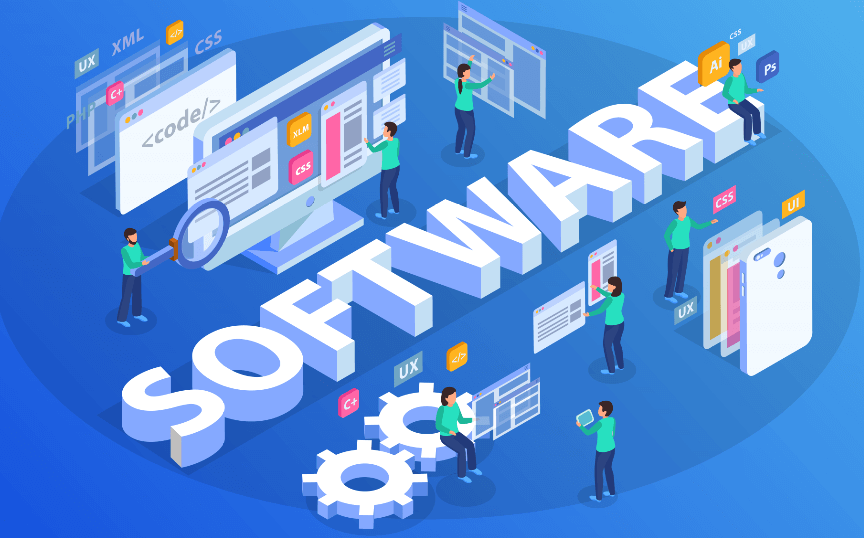Over the years, SIM technology has witnessed a remarkable evolution and has become an integral part of the business world. The traditional physical SIM cards have been replaced by eSIM technology, offering businesses a range of advantages. The advent of eSIM has paved the way for enhanced mobility and flexibility in corporate connectivity. With eSIM, businesses no longer rely on physical SIM cards that must be inserted and swapped between devices. Instead, they can remotely provision and manage connectivity for their devices, making it easier for employees to switch devices or work from different locations without hassle. For businesses looking to leverage eSIM for seamless international connectivity, eSIM for International Roaming offers an efficient solution, ensuring that employees remain connected, no matter where their work takes them.
Furthermore, the convenience and efficiency of eSIM technology are amplified through dedicated applications available for Android and iOS devices. Android users can access these benefits through the Google Play Store, while iPhone users can find the necessary applications on the App Store. These platforms provide an intuitive interface for managing eSIM profiles, enabling businesses and individuals alike to enjoy the full advantages of eSIM technology with ease. For global travel or local connectivity, eSIM technology represents a significant leap forward in mobile communication for the business world.
Furthermore, the adoption of eSIM technology has resulted in significant cost reduction and simplified device management for businesses. With eSIM, the need for physical SIM cards and their associated costs, such as purchasing, installing, and replacing, is eliminated. Enterprises can now easily manage their connected devices through a centralized platform, allowing for more streamlined device provisioning and monitoring processes. This not only saves costs but also simplifies the overall device management workflows, enabling businesses to allocate resources more efficiently.
- eSIM technology has replaced traditional physical SIM cards in the business world
- eSIM offers enhanced mobility and flexibility in corporate connectivity
- Remote provisioning and management of connectivity allows for easy device switching and location changes for employees
- Adoption of eSIM technology results in significant cost reduction for businesses
- Elimination of purchasing, installing, and replacing physical SIM cards saves costs
- A centralized platform enables streamlined device provisioning and monitoring processes
- Simplified device management workflows allow for more efficient resource allocation
Contents
- Enhancing Mobility and Flexibility in Corporate Connectivity
- Reducing Costs and Simplifying Device Management
- Enabling Global Connectivity and International Expansion
- Enhancing Data Security and Privacy for Enterprises
- Improving Employee Productivity with Seamless Connectivity
- Streamlining Device Provisioning and Deployment Processes
- Enabling Remote Work and Supporting Mobile Workforces
- Enhancing Customer Experience and Service Delivery
- Future Outlook: Advancements and Potential Applications of eSIM Technology in Enterprises
- What is eSIM technology?
- How does eSIM technology benefit enterprises?
- How does eSIM enhance mobility and flexibility in corporate connectivity?
- How does eSIM reduce costs and simplify device management?
- How does eSIM enable global connectivity and international expansion?
- How does eSIM enhance data security and privacy for enterprises?
- How does eSIM improve employee productivity with seamless connectivity?
- How does eSIM streamline device provisioning and deployment processes?
- How does eSIM enable remote work and support mobile workforces?
- How does eSIM enhance customer experience and service delivery?
- What are the future advancements and potential applications of eSIM technology in enterprises?
Enhancing Mobility and Flexibility in Corporate Connectivity
In today’s fast-paced business environment, mobility and flexibility have become crucial factors in corporate connectivity. Gone are when employees were confined to their desks and tied to their office phones. With the evolution of SIM technology, businesses can now provide their employees with seamless connectivity no matter where they are.
The introduction of SIM cards in mobile devices has enabled employees to stay connected and productive even while on the go. Whether it’s accessing emails, participating in video conferences, or accessing corporate resources, employees can now do it all from their smartphones or tablets. This increased mobility and flexibility have not only improved employee productivity but have also allowed businesses to tap into a wider pool of talent as remote work becomes more feasible and efficient. With corporate connectivity no longer limited to physical office spaces, the possibilities for collaboration and innovation are endless.
Reducing Costs and Simplifying Device Management
With the increasing reliance on mobile devices in the business realm, reducing costs and simplifying device management has become a top priority for enterprises. One way this is being achieved is through the implementation of centralized device management systems. These systems allow businesses to track, monitor, and control all their devices from a single platform, eliminating the need for manual management and reducing the associated costs. By streamlining the device management process, businesses can achieve greater efficiency and productivity while saving valuable time and resources.
Furthermore, adopting bring-your-own-device (BYOD) policies has also contributed to cost reduction and device management simplification. Rather than providing employees with company-owned devices, businesses are allowing them to use their devices for work purposes. This not only eliminates the need for device procurement and maintenance but also reduces associated costs such as device insurance and data plans. Additionally, with the proper security measures, BYOD policies can enhance employee satisfaction and flexibility, improving productivity and cost savings in the long run.
Enabling Global Connectivity and International Expansion
The global marketplace has become increasingly interconnected, with businesses expanding their reach beyond borders. In this fast-paced and competitive business environment, having global connectivity is crucial for enterprises to effectively operate and expand internationally. Traditionally, achieving global connectivity has been complex and cumbersome, often involving multiple SIM cards and service agreements. However, advancements in SIM technology have revolutionized the way businesses connect and operate on a global scale.
One of the key advantages of modern SIM technology is the ability to enable seamless global connectivity. With a single embedded SIM (eSIM) card, businesses can easily switch between mobile networks and operators across multiple countries without needing physical SIM cards or changing service providers. This not only simplifies the process of expanding into new markets but also provides businesses with the flexibility to choose the most cost-effective and reliable network connections wherever they operate. The eSIM technology streamlines the connectivity process, allowing enterprises to focus on their core business objectives and rapidly expand their global footprint.
Enhancing Data Security and Privacy for Enterprises
Data security and privacy have become paramount for enterprises in today’s rapidly evolving digital landscape. With the increasing amount of sensitive information being stored and transmitted electronically, businesses are under constant pressure to ensure the confidentiality, integrity, and availability of their data. One solution that has emerged to address these challenges is using SIM technology.
SIM technology offers enhanced data security and privacy for enterprises by providing a secure and encrypted channel for transmitting data between devices and networks. By leveraging encryption algorithms and authentication protocols, SIM cards enable businesses to protect their data from unauthorized access and interception. Additionally, SIM technology offers features such as remote data wiping and device tracking, further enhancing data security in case of loss or theft. By adopting SIM technology, enterprises can not only safeguard their valuable information but also ensure compliance with various data protection regulations and industry standards.
In an era where cyber threats constantly evolve, enterprises must proactively enhance their data security and privacy. SIM technology provides an effective solution to address these concerns by offering secure and encrypted communication channels, remote management capabilities, and compliance with data protection regulations. By investing in SIM technology, businesses can strengthen their data security posture, protect sensitive information, and build trust with their customers and partners. As the threat landscape evolves, adopting SIM technology will be crucial in safeguarding enterprise data and ensuring a secure digital environment for businesses to thrive.
Improving Employee Productivity with Seamless Connectivity
In today’s fast-paced business environment, improving employee productivity is key to achieving organizational success. One vital aspect that plays a significant role in enhancing productivity is seamless connectivity. By seamlessly connecting employees to the necessary resources and information, organizations can empower their workforce to perform at their best, regardless of location or time zone.
With the advent of advanced communication technologies, such as mobile devices and cloud-based applications, employees are no longer confined to their desks or traditional working hours. Seamless connectivity enables employees to access work-related data, collaborate with colleagues, and respond to critical tasks, all from the convenience of their preferred devices. Whether working from home, on the go, or in a different country, employees can stay connected in real time, ensuring uninterrupted workflow and efficient task completion. This flexibility not only improves employee satisfaction but also promotes a healthy work-life balance, ultimately leading to higher levels of productivity and overall performance.
Streamlining Device Provisioning and Deployment Processes
In today’s fast-paced business environment, streamlining device provisioning and deployment processes has become essential for enterprises looking to stay competitive and efficient. With the constant evolution of technology and the increasing reliance on mobile devices, businesses need to ensure a seamless and hassle-free process for setting up and deploying devices to their employees.
One of the key benefits of streamlining device provisioning and deployment processes is the significant reduction in the time and effort required to get devices up and running. By implementing efficient processes and leveraging the latest technologies, businesses can eliminate manual intervention and automate the provisioning and deployment of devices. This not only saves valuable time but also minimizes the chances of errors and ensures consistency across all devices. Whether setting up new devices for new hires or deploying updates and patches to existing ones, a streamlined process ensures a smooth experience for IT teams and end-users, ultimately improving productivity and cost-effectiveness.
Enabling Remote Work and Supporting Mobile Workforces
With the rapid advancement of technology, remote work has become increasingly prevalent in today’s business landscape. The ability for employees to work from anywhere, at any time, has revolutionized the traditional notion of work-life balance. Mobile workforces can now seamlessly collaborate and contribute to projects regardless of their physical location.
This shift towards remote work has been made possible by the advent of connectivity solutions such as SIM technology. By enabling employees to access corporate resources and connect to their colleagues through secure and reliable connections, businesses can support a mobile workforce that is both productive and efficient. This flexibility allows employees to choose when and where they work, leading to increased job satisfaction and higher employee retention rates. Additionally, businesses can save on costs associated with office space and utilities, further enhancing the appeal of remote work.
Enhancing Customer Experience and Service Delivery
In today’s fast-paced business environment, enhancing the customer experience and service delivery has become a top priority for enterprises. With the evolution of SIM technology, businesses can now provide seamless connectivity and personalized services to their customers. This has significantly transformed the way businesses interact with their customers, leading to improved satisfaction and loyalty.
Through the use of advanced SIM technology, businesses can now offer customized solutions that cater to the specific needs of individual customers. Whether it’s a personalized mobile app, tailored promotions, or real-time support, businesses can leverage SIM technology to provide a seamless and personalized experience. This not only enhances customer satisfaction but also leads to increased sales and revenue. Furthermore, businesses can now gather valuable data through SIM technology, enabling them to gain insights into customer preferences and behavior. This data can then be used to enhance the customer experience further and drive business growth.
Future Outlook: Advancements and Potential Applications of eSIM Technology in Enterprises
Advancements in eSIM technology are paving the way for exciting potential applications in the enterprise world. With eSIMs, businesses can benefit from increased flexibility, streamlined device management, and enhanced connectivity. This technology allows enterprises to easily switch between different mobile networks and plans, eliminating the need for physical SIM cards and reducing costs associated with device provisioning and deployment.
Furthermore, eSIMs enable global connectivity and international expansion for businesses. With a single eSIM, employees can access mobile networks in various countries without the hassle of swapping SIM cards. This not only simplifies the process of international travel but also enhances productivity and efficiency for enterprises with global operations. Additionally, eSIM technology offers improved data security and privacy, ensuring that sensitive business information remains protected even in remote and mobile working scenarios. As the demand for seamless connectivity and efficient device management continues to grow, eSIM technology is set to revolutionize how enterprises operate, unlocking new opportunities for growth and success.
What is eSIM technology?
eSIM technology refers to an embedded SIM card that is built directly into a device. It eliminates the need for a physical SIM card and allows for remote provisioning and management of mobile network connectivity.
How does eSIM technology benefit enterprises?
eSIM technology offers advantages such as enhanced mobility and flexibility in corporate connectivity, reduced costs and simplified device management, global connectivity, and international expansion, improved data security and privacy, increased employee productivity, streamlined device provisioning and deployment processes, support for remote work and mobile workforces, and enhanced customer experience and service delivery.
How does eSIM enhance mobility and flexibility in corporate connectivity?
eSIM allows enterprises to switch between mobile network operators easily without changing physical SIM cards. This flexibility enables seamless connectivity wherever employees are located, domestically and internationally.
How does eSIM reduce costs and simplify device management?
With eSIM, enterprises can avoid the expenses associated with physical SIM cards, such as procurement, distribution, and replacement. Additionally, eSIM technology simplifies device management through over-the-air provisioning, enabling remote configuration and updates without needing physical access to devices.
How does eSIM enable global connectivity and international expansion?
eSIM provides the ability to connect to local networks in different countries, eliminating the need for employees to rely on roaming services. This allows enterprises to expand their operations internationally without the hassle of changing SIM cards or dealing with multiple contracts.
How does eSIM enhance data security and privacy for enterprises?
eSIM technology provides a secure and tamper-resistant environment for storing authentication credentials. It enables robust authentication and encryption mechanisms, protecting sensitive enterprise data and ensuring secure communication between devices and networks.
How does eSIM improve employee productivity with seamless connectivity?
eSIM enables employees to stay connected to the internet and corporate networks wherever they are without relying on external Wi-Fi networks or physical SIM cards. This uninterrupted connectivity boosts productivity by allowing employees to access critical resources and collaborate seamlessly.
How does eSIM streamline device provisioning and deployment processes?
eSIM simplifies the process of provisioning and deploying devices by eliminating the need for physical SIM cards. IT administrators can remotely provision, activate, and configure eSIMs, reducing the time and effort required to set up new devices for employees.
How does eSIM enable remote work and support mobile workforces?
With eSIM, remote workers can easily connect to corporate networks and access resources securely, regardless of location. eSIM technology allows for seamless connectivity in various countries, enabling enterprises to support mobile workforces without connectivity limitations.
How does eSIM enhance customer experience and service delivery?
eSIM technology enables enterprises to provide customers with connected devices ready to use out of the box. It simplifies the activation process, reduces setup time, and ensures a smooth and seamless experience for customers when connecting to mobile networks.
What are the future advancements and potential applications of eSIM technology in enterprises?
The future of eSIM technology in enterprises looks promising, with potential applications in areas such as IoT connectivity, smart cities, connected vehicles, wearables, and more. As the technology evolves, new use cases and enterprise opportunities are expected to emerge.



